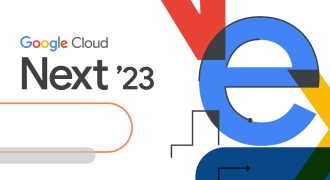
Blog
TelcoDR’s Watch List for Google Cloud Next ’23
Google Cloud Next runs from August 29-31. Check out my hand-picked shortlist of must-see topics for telcos.
I 💘 MWC. Remember my big coming-out party in 2021, when Ericsson pulled its sponsorship at the last minute and TelcoDR took over its 6,000 square meter exhibit space? We created CLOUD CITY in less than 100 days, and called on telcos to ride the dragon and move to the public cloud ASAP. Good times.
While there was no CLOUD CITY at MWC this year, people STILL talk about that day. In two years’ time we have accomplished what we set out to do: drive telco towards the public cloud. I mean, even the GSMA Director General Mats Granyrd was talking about APIs during his opening keynote. Crazy!
With more than 88,500 participants, 2,400 exhibitors, and 1,000 speakers, plus tons of announcements, there was a lot going on. There have been tons of rundowns on what happened in Barcelona this year, but I still haven’t seen anyone give the Cloudy Update. So I’ve rounded up all the cloudy news for you. Read below for happenings with the hyperscalers, telcos moving to the cloud, and vendor musings. Enjoy!
In 2019, the hyperscalers were hardly present at MWC. This year, it felt like a takeover. Hyperscalers are now a huge part of MWC; some coverage even called this “unofficially, the story of MWC23.” Each of the Big Three launched products for telcos and made important industry-specific announcements to time with the event. So let’s break down what each had to say:
Amazon Web Services’ (AWS) presence at MWC was felt from the start: at the Fira’s south entry—THE entrance at MWC—every attendee immediately saw its “Level Up with AWS” banner leading up the escalators to the upper level where its main stand resided (pun intended, I’m sure).
In general, AWS is just crushing it in telco. The week before the conference, it announced AWS Telco Network Builder, designed to help telcos quickly spin up network resources on AWS, and Integrated Private Wireless, which combines AWS infrastructure with pre-integrated networks from Deutsche Telekom, KDDI, Orange, T-Mobile and Telefonica Tech to give enterprises a fast, easy option for private wireless. I especially enjoyed Jeff Barr’s blog, which broke down the steps for using Telco Network Builder, giving everyone the down-low on how to take advantage of this new service.
During MWC, AWS and Nokia jointly announced a Cloud Radio Access Network (RAN) solution that combines AWS infrastructure and cloud services with Nokia’s new In-Line Cloud RAN SmartNIC and Cloud Native RAN software. The goals are to simplify the integration and deployment of a disaggregated hardware and software stack, enable carrier-grade RAN performance in a single server with high radio density, and streamline configuration and maintenance once the solution is live.
And finally, I have to give a shout-out to the folks behind AWS Studio, where telco and AWS experts got together to talk shop and share ideas to inspire the next wave of innovation. Recordings of 300+ sessions (!) should be available in some fashion soon. I’m looking forward to watching “Becoming a cloud-native telco operator in record time” with Sudhanshu Sinha of Totogi (who-hoo!), where I’m acting CEO.
1/3 🎉🎤🌐 Yesterday's panel session in the AWS studio was awesome! 🙌 Sudhanshu Sinha, SVP of Totogi, joined @AWS and @MoflixGroup to discuss 'Becoming a cloud-native Telco Operator in record time'. #Totogi #MWC23 #AWSNextLevel #Telco #CloudNative pic.twitter.com/Hq1f2R9aCa
— Totogi (@totogi) February 28, 2023
Not to be outdone and working hard to displace AWS, Microsoft announced a bunch of new and improved services in its Azure for Operators suite. It didn’t make ANY telco announcements at Ignite 2022 (its big conference), and you may recall that I was like, WHAT’S UP WITH THAT? Well, now I know: it was piling them up for a mother lode drop of announcements at MWC23. Holy cow—eight announcements around telco and the public cloud. The various solutions aim to accelerate network transformation, help telcos build innovative applications, unlock opportunities with automation and artificial intelligence (AI), and enable cloud-to-edge computing.
Azure Operator Nexus, now in public preview, is a carrier-grade, hybrid platform for running telecom workloads on-premises or on Azure. You can deploy it on the operator near or far edge, or consume it as a service, with an expected 35% total cost of ownership (TCO) savings on do-it-yourself private network functions virtualization infrastructure (NFVi).
Azure Communications Gateway, a solution for connecting fixed and mobile networks to Microsoft Teams, is now generally available. Azure Operator Voicemail, in private preview, is a fully managed service that enables operators to transition their legacy voicemail systems to Azure. Both services aim to support operators as they migrate voice workloads to the cloud.
Flexing its new, rising star reputation for AI (thanks, ChatGPT!), the hyperscaler also announced two new automation and AI services: Azure Operator Insights and Azure Operator Service Manager. These hybrid services make it easier to manage existing networks and ensure that other Azure for Operators services are monitored, diagnosed, and managed in the same way. Both available for public preview.
Other Azure announcements:
Google Cloud promoted three new telco services of its own, all with the aim of helping operators with digital transformation and finding new revenue opportunities: Telecom Network Automation, Telecom Data Fabric, and Telecom Subscriber Insights (okay, who isn’t working on subscriber insights?). Together, they offer a unified solution to help build, deploy, and operate hybrid, cloud-native networks, as well as collect and manage data so it can be put to work to improve customer experiences through AI and analytics.
Google also announced an update to Distributed Cloud Edge, which can now run radio access network (RAN) functions as software, giving CSPs a common operating model from the network core to the edge.
Mike Dano at Light Reading has an interesting take on how Google Cloud is taking a less threatening approach to the telco industry than other public cloud providers. Unlike AWS and Azure, Google Cloud has no plans to compete with telcos on private wireless networking or network functions. Instead, it wants to work with the likes of Ericsson and Mavenir to develop those services for enterprises and other end-customers. My take: we shall see. I recall Azure saying the same thing. Private networking may prove to be too tantalizing for Google to miss out on.
When we built CLOUD CITY two years ago, telcos were still kicking the tires of the public cloud. It was still a question of if they would, or should, embrace it. Now, it’s game over. Everyone is doing it, and besides moving workloads to the cloud, telcos are starting to experiment with the software of the public cloud. Like…
In a surprise move, the GSMA announced a new, industry-wide initiative called GSMA Open Gateway. It’s a framework of universal network APIs designed to provide universal access to operator networks for developers. DISH Wireless rocked the telco world when it announced its network APIs last fall; Microsoft’s announcement of its Connectivity API is another example. With 21 (and growing) mobile network operators supporting GSMA Open Gateway’s launch, this idea seems to be gaining a lot of momentum.
Swisscom, Ericsson, and AWS are working together on a 5G Core for hybrid cloud. The proof-of-concept (PoC) trial has Ericsson 5G Core applications running on AWS to explore how the use cases support the needs of operators. The trial will focus on the flexibility that hybrid cloud can offer, complementing existing public or private cloud infrastructure.
Telcos are embracing AI and machine learning (ML). McKinsey published an insights piece about how AI presents a huge opportunity for telcos right now. Omdia shared a roundup of the notable AI/ML project announcements made around the show, including from Nokia, Microsoft, Amdocs, and Google Cloud.
During the show, Google Cloud posted a blog about four trailblazing operators in Asia Pacific who are finding new revenue streams by using the public cloud and AI. StarHub is delivering 5G in Singapore. Indosat is helping small businesses in Indonesia. Chungwha is developing its own smart voice assistant in Taiwan. Optus is improving customer service in Australia. The ways telcos are using the public cloud and its services are as varied as the telcos themselves.
And the biggest eye roll announcement (at least for me): an update on Project Sylva. The European effort to create an open-source telco cloud framework is aimed at building a better cloud for telco, but it may be just building an ivory tower for itself. While the group of carriers and network vendors meets to think about how to compete with the hyperscalers, the hyperscalers are busy making deals, inking partnerships, and shipping innovative software. A consortium trying to collaborate to build a public cloud is a tall order when the Big Three have a 17-year head start. Good luck with that.
The most talked-about presentation at the event was… mine! I rocked the stage at the MVNO Summit as the acting CEO of Totogi, talking about the power of the public cloud, Software as a Service (SaaS) models in telco, and demonstrating some new Totogi products: Charging-as-a-Service and Churn Prediction Service. At the Totogi booth (and at the Supercharged Fiesta after my talk), we pulled out all the stops to showcase the potential of our business support system (BSS) enhancement platform. We’re still getting meetings from MWC—two weeks after the event. Insane.
And, on the heels of the AWS Integrated Private Wireless announcement, we also demoed a Private Enterprise Network (PEN) solution with AWS and Tech Mahindra to show how enterprise customers can monetize their PENs. It uses Totogi’s Charging-as-a-Service to allow enterprises to charge end-users for PEN access without affecting the operators’ main charging function or interfering with other enterprise customers on the same platform. Enterprises have been wanting this capability for years, but old charging stacks make it difficult to share the charging engine with other tenants AND maintain the ability to protect the charging capacity reserved for their main lines of business.
But not with Totogi. Because Totogi is a multi-tenant system that runs fully in the public cloud and is so easy to spin up and down, you can quickly create instances for your enterprise customers without worrying about interference with your main charger. For example, this year’s Super Bowl had a state-of-the-art private wireless network at the stadium for event staff to use to manage logistics. Using our solution, event organizers could have opened it to spectators and charged for access to the superior network during the game, and then broken it down after the event. A quote from a US Tier 1: “Impressive, and I don’t impress easily.” ‘Nuff said.
Throughout the event halls, vendors were bragging about being powered by the public cloud in their booths, with “Powered by” hyperscaler messaging stamped right onto their stands. Gorsel Baksi, an AWS principal partner development manager for OSS/BSS vendors, did some of his own bragging about the shout-outs. Included: a shot of the side of the Totogi bus!
All in all, my team and I loved our time in Barcelona. My voice is just starting to come back—just in time for spring break with my kids. Hasta la vista, MWC! Until next year, when hopefully everyone is still reminiscing about how awesome CLOUD CITY was and the public cloud is still absolutely everywhere—maybe even I won’t be surprised anymore.
Recent Posts

 Get my FREE insider newsletter, delivered every two weeks, with curated content to help telco execs across the globe move to the public cloud.
Get my FREE insider newsletter, delivered every two weeks, with curated content to help telco execs across the globe move to the public cloud.